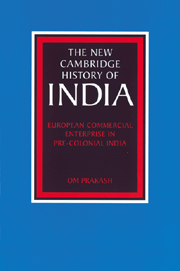Crossref Citations
This Book has been
cited by the following publications. This list is generated based on data provided by Crossref.
1998.
The Best of Two Worlds: An Interview with Om Prakash.
Itinerario,
Vol. 22,
Issue. 2,
p.
9.
Kochhar, Rajesh
1999.
The truth behind the legend: European doctors in pre-colonial India.
Journal of Biosciences,
Vol. 24,
Issue. 3,
p.
259.
Dale, Stephen
2000.
The New Cambridge History of Islam.
p.
266.
Levi, Scott C.
2000.
The New Cambridge History of Islam.
p.
561.
Morgan, David O.
and
Reid, Anthony
2000.
The New Cambridge History of Islam.
Kamps, Ivo
2001.
Travel Knowledge.
p.
149.
Kamps, Ivo
2001.
Travel Knowledge.
p.
160.
Trivellato, Francesca
2003.
Juifs de Livourne, Italiens de Lisbonne, hindous de Goa: Réseaux marchands et échanges interculturels à l’époque moderne.
Annales. Histoire, Sciences Sociales,
Vol. 58,
Issue. 3,
p.
581.
Bes, Lennart
2003.
Hundreds of Rosetta Stones and Other Patient Papers: The Dutch Records at the Tamil Nadu Archives, Chennai (Madras).
Itinerario,
Vol. 27,
Issue. 1,
p.
93.
Shimada, Ryuto
2003.
Dancing around the Bride: The Inter-Asian Competition for Japanese Copper, 1700–1760.
Itinerario,
Vol. 27,
Issue. 2,
p.
37.
D’Souza, Florence
2004.
Imperialisms.
p.
111.
Maddison, Angus
2004.
La economìa de occidente y la del resto del mundo en el último milenio.
Revista de Historia Económica / Journal of Iberian and Latin American Economic History,
Vol. 22,
Issue. 2,
p.
259.
Vink, Markus
2004.
From Port-City to World-System: Spatial Constructs of Dutch Indian Ocean Studies, 1500-1800.
Itinerario,
Vol. 28,
Issue. 2,
p.
45.
Mielants, Eric
2005.
The Historical Evolution of World-Systems.
p.
122.
Scarre, Chris
and
Roberts, Judith
2005.
The English Cemetery at Surat: Pre-Colonial Cultural Encounters in Western India.
The Antiquaries Journal,
Vol. 85,
Issue. ,
p.
251.
ALAMGIR, ALENA K.
2006.
“The Learned Brāhmen, Who Assists Me”: Changing Colonial Relationships in the 18th and 19th Century India.
Journal of Historical Sociology,
Vol. 19,
Issue. 4,
p.
419.
Maddison, Angus
2006.
Asia in the World Economy 1500–2030 AD.
Asian-Pacific Economic Literature,
Vol. 20,
Issue. 2,
p.
1.
Kampmann, Christoph
Müller, Winfried
Asch, Ronald G.
Asbach, Olaf
Bosbach, Franz
Steiger, Heinhard
Fischer, Norbert
Beutel, Albrecht
Leicht, Reimund
Vogel, Christine
Riekenberg, Michael
Mahlerwein, Gunter
Plumpe, Werner
Denzel, Markus A.
Köppen, Thomas
Graf, Friedrich Wilhelm
Sparn, Walter
Schnettger, Matthias
Bruning, Jens
Rheinhardt, Jens
Rosenke, Stephan
Konersmann, Frank
Hoppe, Stephan
Hochadel, Oliver
Kroll, Stefan
Bischoff, Harald
Kalusok, Michaela
Wiener, jürgen
Meinel, Christoph
Wenzel, Silke
Jancke, Gabriele
Fuchs, Antje
Huber, Martin
Kirchner, Thomas
Edler, Arnfried
Keunecke, Susanne
Grethlein, Christian
Wrede, Martin
Labouvie, Eva
Henze, Martina
Walther, Gerrit
Wagner, Michael
Agethen, Manfred
Schorkopf, Frank
Salatowsky, Sascha
Naphy, William
Ehmer, Josef
Wassilowsky, Günther
Scheitler, Irmgard
Andermann, Kurt
Groote, Inga Mai
Rieter, Heinz
Metz, Rainer
Stockhorst, Stefanie
Kremer, Joachim
Coester, Christiane
Wieland, Christian
Becher, Ursula A. J.
Döring, Detlef
Gierl, Martin
Košenina, Alexander
Häseler, Jens
Eisfeld, Jens
Krug-Richter, Barbara
Weber, Wolfgang E. J.
Hirschfelder, Gunther
Schaier, Joachim
Nowosadtko, Jutta
Graf, Klaus
Andres, Jan
Synofzik, Thomas
Waczkat, Andreas
Bahlcke, Joachim
Aurnhammer, Achim
Kepetzis, Ekaterini
Heyl, Christoph
Teuteberg, Hans Jürgen
Schröder, Iris
Fritscher, Bernhard
Epple, Moritz
Beuttler, Ulrich
Köster, Roman
Übler, Rebekka
Simon, Thomas
Härter, Karl
Lorenz, Maren
Mohnhaupt, Heinz
Weitzel, Jürgen
Oestmann, Peter
Hirschi, Caspar
Müller, Gemot Michael
Frassek, Ralf
Heuser, Peter Arnold
Hohkamp, Michaela
Fischer, Michael
Jordan, Stefan
Ramonat, Oliver
Niefanger, Dirk
Lehr, Thomas
Nordalm, Jens
Sommer, Andreas Urs
Süßmann, Johannes
Ulbrich, Claudia
Jarzebowski, Claudia
Kanz, Roland
Fertig, Georg
Reith, Reinhold
Albrecht, Clemens
Schmale, Wolfgang
Kohl, Gerald
Klippel, Diethelm
Flüchter, Antje
Hofer, Sibylle
Klußmann, Jan
Rehm, Ulrich
Eckart, Wolfgang UWG
Thier, Andreas
Spode, Hasso
Göttmann, Frank
König, Hans-joachim
Pállinger, Zoltán
Gadebusch-Bondio, Mariaclara
Reininghaus, Wilfried
Pfister, Ulrich
Keller, Katrin
Laufer, Johannes
Gömmel, Rainer
Mittag, jürgen
Bartels, Christoph
Leppin, Volker
Garré, Roy
Becchi, Antonio
Teuteberg, Hans Jürgen
Beck, Thomas
Klein, Birgit E.
Seidel, J. Jürgen
Wahrig, Bettina
Sölch, Brigitte
Reith, Remhold
Nüssel, Friederike
Lucassen, Jan
Lucassen, Leo
Koch, Elisabeth
Strohmeyer, Arno
Reulecke, Martin
Torres, Max Sebastián Hering
Bley, Helmut
König, Hans-Joachim
Lottes, Günther
Rohmer, Ernst
Newmark, Catherine
Pahlow, Louis
Fenske, Michaela
Ruhstorfer, Karlheinz
Peil, Dietmar
Haberlein, Mark
Scholz-Hänsel, Michael
North, Michael
Bleidick, Dietmar
Schmidt-Voges, Inken
Laube, Martin
Reichmuth, Stefan
Kummels, Ingrid
Rüther, Kirsten
Enders, Markus
Matthias, Markus
Bärsch, Jürgen
Wendebourg, Dorothea
Loeser, Martin
Ruppert, Stefan
Schwerhoff, Gerd
Link, Christoph
Zitzlsperger, Philipp
Fessner, Michael
Vanek, Klara
Appuhn-Radtke, Sibylle
Würgler, Andreas
Landfester, Manfred
Keil, Hartmut
von Kondratowitz, Hans-Joachim
Stauber, Reinhard
Akashi, Kinji
Gareis, Iris
Hesse, Jan-Otmar
Felmy, Karl Christian
Behringer, Wolfgang
Jatzlauk, Manfred
Mittag, Achim
Gestrich, Andreas
Eibach, Joachim
Neschwara, Christian
Blickle, Peter
Löhnig, Martin
Naphy, William G.
Schmidt, Peer
Reichardt, Rolf
Schneider, Konrad
Flügel, Axel
Brauneder, Wilhelm
and
Münch, Ernst
2006.
Enzyklopädie der Neuzeit.
p.
1.
Sachdeva, Gulshan
2008.
India and the European Union.
International Studies,
Vol. 45,
Issue. 4,
p.
341.
Chandra, Satish
2009.
Social and Attitudinal Change in Medieval India.
Indian Historical Review,
Vol. 36,
Issue. 1,
p.
23.



